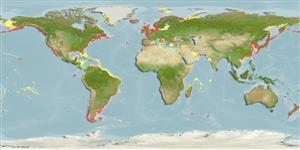Polychaeta |
Phyllodocida |
Nereididae
Environment: milieu / climate zone / ระดับความลึก / distribution range
นิเวศวิทยา
. Tropical
Arctic, Indo-Pacific, Atlantic Ocean and the Mediterranean Sea.
Length at first maturity / ขนาด / Weight / Age
วัยเจริญพันธุ์: Lm ? range ? - ? cm Max length : 20.3 cm TL เพศผู้/กระเทย; (อ้างอิง 111270); common length : 12.0 cm TL เพศผู้/กระเทย; (อ้างอิง 111269); อายุสูงสุดที่ได้รายงาน: 3.00 ปี (อ้างอิง 111266)
Predominantly intertidal, occasionally found subtidally. Adults may be found in a mucous tube, under boulders or on holdfasts of algae (Ref. 111185). Omnivorous, feeding on plant detritus, algae, and sometimes on harpacticoid copepods and amphipods (Ref. 108780).
Mating: Females produce a pheromone attracting and signalling the males to shed sperm which in turn stimulates females to shed eggs, this behavior is known as swarming. Gametes are spawned through the metanephridia or body wall rupturing (termed as "epitoky", wherein a pelagic, reproductive individual, "epitoke", is formed from a benthic, nonreproductive individual, "atoke"). After fertilization, most eggs become planktonic; although some are retained in the worm tubes or burrowed in jelly masses attached to the tubes (egg brooders). Life Cycle: Eggs develop into trocophore larva, which later metamorph into juvenile stage (body lengthened), and later develop into adults (Ref. 833). The worms die after their breeding period (Ref. 111269). Also Ref. 111267.
Salazar-Vallejo, S.I. 1996 Lista de species y bibliografía de Poliquetos (Polychaeta) del Gran Caribe. Anales Inst. Biol. Univ. nac. Autón, México, Ser. Zool. 67(1):11-50. (อ้างอิง 7866)
IUCN Red List Status
(อ้างอิง 130435: Version 2025-1)
CITES status (อ้างอิง 108899)
Not Evaluated
CMS (อ้างอิง 116361)
Not Evaluated
Threat to humans
Human uses
| FishSource |
เครื่องมือ
ข้อมูลเพิ่มเติม
Human RelatedStamps, coins, misc.
แหล่งที่มาจากอินเตอร์เน็ต
Estimates based on models
Preferred temperature
(Ref.
115969): 1.4 - 18.7, mean 7.1 (based on 1980 cells).
Fishing Vulnerability
Low vulnerability (16 of 100).
Price category
Unknown.
